Processing Poultry Meat for Sale: The Right Approach for Your Farm?
 Print This Post
Print This Post
By Ann Baier, NCAT Sustainable Agriculture Specialist
As I’ve worked on NCAT’s pastured poultry projects for a few years, I’ve been listening to and learning from smart entrepreneurial farmers who are finding ways to make their businesses work. While wonder and curiosity, idealism, and hard work were characteristic of my childhood and early farming experiments, I am increasingly appreciative of the breadth of knowledge, perspective, and skills needed to develop a successful poultry business.
Beginning poultry producers commonly ask How do I navigate poultry processing regulations for selling poultry meat? or Does it make more sense to process my broilers on-farm or to take them to a processing facility? There are two main approaches to processing poultry meat for sale: 1) USDA inspected; or 2) Exempt from USDA inspection. The latter includes on-farm processing, and state-licensed facilities (see further explanation below). Which approach is right for your farm depends on your location, production volume, and intended customers.

USDA-Inspected Poultry processed in a USDA plant receive continuous, bird-by-bird inspection by a USDA poultry inspector. Processing birds in a USDA-inspected facility offers the greatest flexibility for marketing. You can process any number of birds, and sell poultry meat to any type of customer, even across state lines. One challenge is finding a plant that will work for you. Although there are many USDA-inspected plants across the country, only a few slaughter birds for independent producers. Search by state and activities (slaughter) in the Food Safety Inspection Service (FSIS)’s Meat, Poultry and Egg Product Inspection Directory then contact plants to ask if they will process your birds.
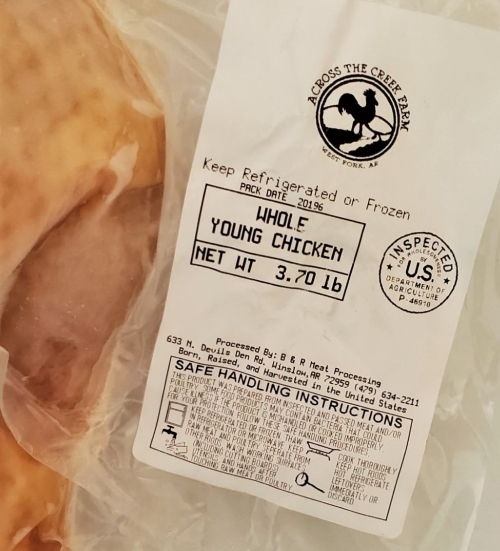
Chicken processed at a USDA-inspected facility.
Once you find a plant, you need a practical way to transport live birds and time for them to be processed. If plants are distant from the farm, transportation can be time-consuming and stressful to both birds and people. Talking to other farmers about their experiences with plants is the most practical and efficient way to identify a plant whose processing and packaging services might be right for your farm and marketing plans. If you do not have a farmer network, join one! Two organizations that facilitate active sharing of information and support among producers and processors are:
American Pastured Producers Association (APPPA), a nonprofit trade organization, offers information resources and networking opportunities.
Niche Meat Processors Association Network (NMPAN), a national extension project, manages an active listserve for exchange of processing procedures, equipment, regulations, feasibility and profitability. See research, case studies and guides on the website: A Best-Practices Guide to Open-Air Poultry Slaughter.
On-Farm Poultry Processing (with Federal and State Inspection Exemptions)
On-farm processing has many potential advantages, including reducing the stress of long-distance transport. However, on-farm processing requires not only skill and hard work, but also commitment to consistent procedures for good sanitation, quality control, recordkeeping.
Regardless of where it takes place, processing needs to meet the requirements of the Poultry Products Inspection Act to ensure poultry products are “wholesome, not adulterated, and properly marked, labeled, and packaged.” You can process legally either on-farm or in a state-licensed facility if you meet the criteria for Exemption from USDA Inspection (see: Guidance for Determining Whether a Poultry Slaughter or Processing Operation is Exempt from Inspection Requirements of the Poultry Products Inspection Act.) and follow all other applicable federal, state and local regulations. USDA exemptions limit sales to 1,000 or 20,000, mostly direct to consumers.
State and Local Regulations are Complex
In addition to USDA exemption, on-farm processing must meet state criteria for inspection or exemption, many of which are more restrictive than federal exemptions. Regulations vary widely in states that do not have an inspection program that is equivalent to USDA. The Farm-to-Consumer Legal Defense Fund offers this State-by-State* Review of On-Farm Poultry Processing Laws, Poultry Map and Chart. Consult with your State Departments of Food and Agriculture, Food and Agricultural Code, Health and Safety Code, Food Retail Code, County Health Departments, or other appropriate agencies.
Local regulations also come into play with respect to everything from building codes to sale of products at farmers markets. Producers must comply with all applicable regulations. Steps to find, understand and comply with regulations take time, patience, and perseverance!
Farmers Caleb Barron of Fogline Farm and Gary Roberts of Zentner’s Fogbound Farm shared their experience in ATTRA’s podcast episode 98. and explained how they make their decisions about processing birds. Caleb became skilled and efficient at on-farm processing, but as he clarified his priorities, concluded that it made sense to take his birds to be processed at a USDA plant so he could grow his business to more than 20,000 birds per year, and market poultry meat to restaurants. Gary mentioned efforts to address California state inspection exemptions that are more restrictive than federal regulations with respect to the number of birds that can be processed.
Choose the Appropriate Path for your Farm
No matter which regulatory pathway you choose—USDA plant, state-licensed plant, or on your own farm (under USDA and state inspection exemptions) — the underlying goals are the same: Ensure quality standards (healthy birds, sanitary processing, proper labeling) to produce wholesome food, please your customers, and keep them safe and healthy. Choose an approach that meets both the spirit and the letter of the regulations, and your farm and family goals.
Over the coming months, I will be working hard to revise some of ATTRA’s older publications, and to collect specific topic-based resources for poultry entrepreneurs. Please feel free to send questions and suggestions! In the meantime, here are a few resources related to poultry processing and production.
Related Resources
Small-Scale Poultry Processing
Meat Plants: Improving Profitability in Small and Very Small Operations
Small Poultry Processing Plants and Services, a self-listing directory of poultry processing facilities, not limited to USDA plants. Although it includes a limited number of plants at this time, it will be more complete if you add yours!
A Best-Practices Guide to Open-Air Poultry Slaughter, by Lauren Gwin and Rebecca Thistlethwaite. Also available in Spanish: La guía de buenas prácticas para el sacrificio al aire libre de aves de corral.
For more information on this topic, contact Ann Baier directly at annb@ncat.org.
This blog is produced by the National Center for Appropriate Technology through the ATTRA Sustainable Agriculture program, under a cooperative agreement with USDA Rural Development. ATTRA.NCAT.ORG.

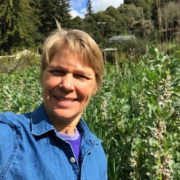
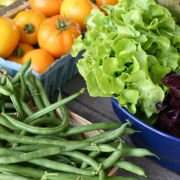 USDA
USDA
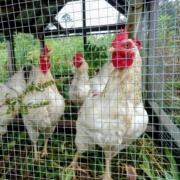

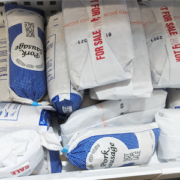
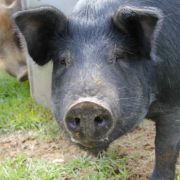
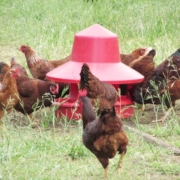
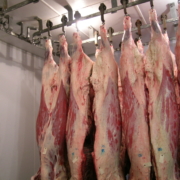 Photo: Arion Thiboumery
Photo: Arion Thiboumery

